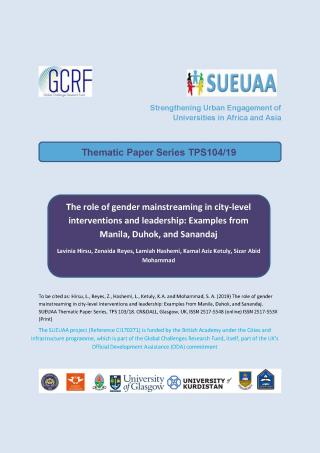In a series of SUEUAA working papers, the team will focus on overarching themes (environment, policy, migration, gender, and the economy), and show the similarities and differences across the different study cities in terms of the capacity of the University to respond to these city-wide issues.
The fourth in this series focuses on how Universities respond to the significant drop-off of women as leaders in the labour market, and in doing so address issues of gender, development, and structural inequalities.
Each working paper is a collaborative process, and is co-authored by academics in at least three cities.The second paper is co-authored by Lavinia Hirsu (University of Glasgow), Zenaida Reyes (Philippine Normal University), Lamiah Hasemi (University of Kurdistan), Kamal Aziz Ketuly and Sizar Abid Mohammad (University of Duhok).
Title: The role of gender mainstreaming in city-level interventions and leadership: examples from Manila, Duhok and Sanandaj
Abstract: Making space for women in universities and encouraging their participation in various sectors have become some of the primary goals on many national and regional agendas in the Global South. However, feminist scholars have pointed out that gender mainstreaming failed to accomplish its goals as it primarily encouraged the integration of women in already compromised neoliberal and patriarchal structures, therefore ignoring the collective responsibilities for gender-based inequalities (Alston, 2014).
Recently, there has been a shift by feminist researchers to focus on wider issues of gender and development, to account for the wide range of interrelated issues which may be at play in gender-based inequalities. In this paper, we explore the policies and actions towards gender mainstreaming (both in terms of public engagement, interventions, as well as discussions surrounding empowerment of women). By looking at three case study cities, Manila (Philippines), Duhok (Iraq) and Sanandaj (Iran), we argue that focusing on gender mainstreaming demonstrates both the ways in which women navigate infrastructures in order to make an impact on their communities, but also the areas of development that need to further tackle gender-based inequalities.

